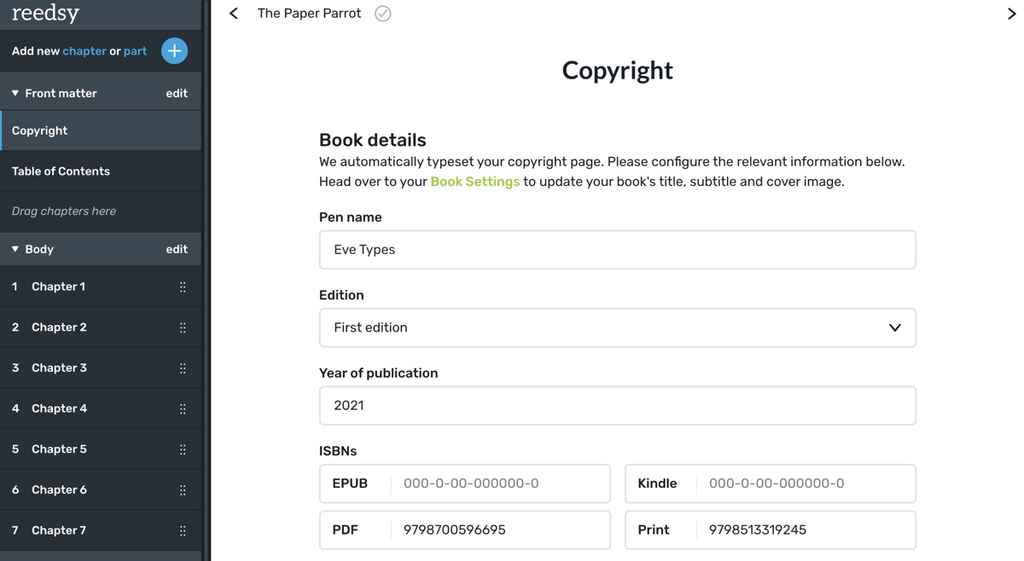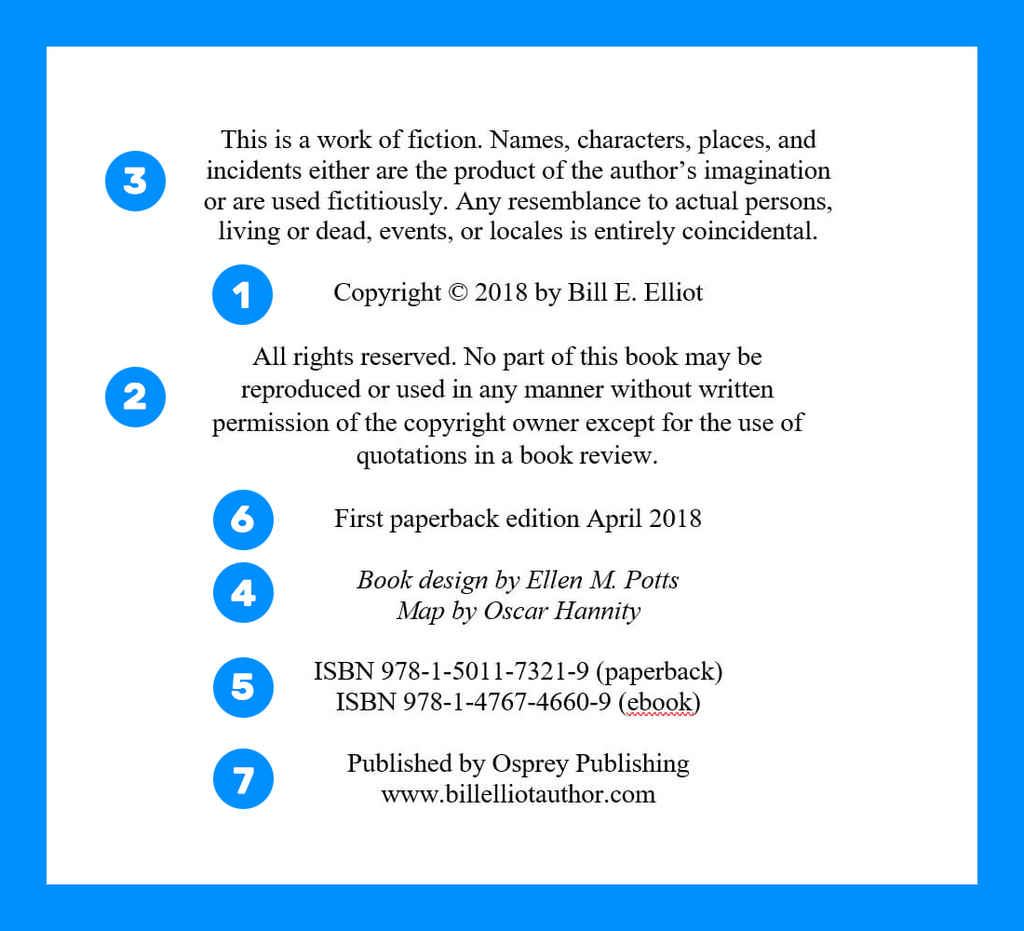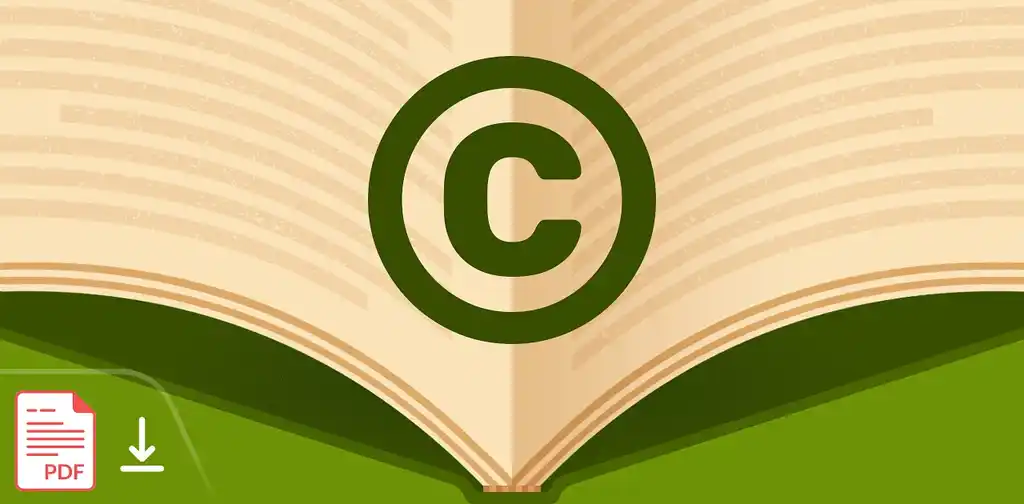Last updated on Sep 03, 2021
How to Create a Copyright Page in 5 Minutes (with Template)
About the author
Reedsy's editorial team is a diverse group of industry experts devoted to helping authors write and publish beautiful books.
More about the Reedsy Editorial Team →Martin Cavannagh
Head of Content at Reedsy, Martin has spent over eight years helping writers turn their ambitions into reality. As a voice in the indie publishing space, he has written for a number of outlets and spoken at conferences, including the 2024 Writers Summit at the London Book Fair.
View profile →A copyright page in a book is a page at the front of a published book that lists information about the book's publication details, copyright, publisher, and ISBN. While it doesn't contribute to the reader's experience (nor is it a legal requirement), it's strongly recommended for authors to include one.
That's because:
- It announces that the work is under copyright and identifies you as the owner
- It discourages infringement
- Your readers may appreciate the information disclosed in it
And last but not least, it’s super easy (and free) to create one. In fact, here’s the template as a .docx, so all you need to do is copy and paste! Just remember to customize it by switching in your own information.
Sign up to download your free copyright template!
You'll get it in your email inbox right after you sign up
If you want something that creates the copyright page entirely for you (and professionally typesets your whole book as well), you can use Reedsy Studio. This free tool automatically generates a copyright page and places it in the right place in the front matter of your book.

Cool, I know how to get a copyright page now. But what exactly is being said on this copyright page?
Glad you asked! Because that’s what the rest of this post is for. Let’s de-mystify the topic by going through each section of the copyright page, one by one. For reference on what each section looks like on the page, you can regularly check back on this image:

1. Copyright Notice
The first thing to know is that you already own the copyright to your work the minute you create it. One more time for the people in the back: you already own the copyright to your work the minute you create it! If you’re curious about the mechanics behind this, you can read up on your rights in this comprehensive guide to copyright.
The job of the copyright notice is simply to declare this to readers: I wrote this book and I own the copyright. It consists of three components:
- “Copyright” and “©”: Since the copyright symbol isn’t recognized in some countries, it’s best to also write it out so there’s no confusion.
- Copyright owner’s name: Assumedly, this will be the author’s name, though it’s perfectly okay to use a pen name or pseudonym.
- Year of publication: Note that this is the year you publish the work (not the year you first created it).
Together, it will give you this copyright statement. Any configuration will do the trick:
Copyright © Anthony Hall, 2014
Copyright © 2014 Anthony Hall
Copyright © 2014 by Anthony Hall
Believe it or not, that’s all you need to tell the world that you own the copyright to your work. If you want, you can also include additional information about copyright dates of previous editions, copyright renewals or other changes, and the country of printing, but none of that is absolutely necessary.
Now we need to inform people about your rights, which takes us to the next step: the reservation of rights.

Get a professional to format your book
Reedsy's professional designers can make your books look like they belong on the bestsellers lists. Sign up for FREE and meet them today.
Learn how Reedsy can help you craft a beautiful book.
2. All Rights Reserved
The page will also include a copyright statement that asks the reader to respect the writer’s rights. To do this, you simply need to write one of the two variations:
All rights reserved.
or
The moral rights of the author have been asserted.
So what exactly do these deceptively short sentences mean?
All rights reserved
This indicates that the copyright owner reserves all the formal rights that copyright protection grants. This includes the right to publish the work, distribute the work, and make derivative works out of it.
Moral rights
Asserting moral rights — separate from economic rights — is a way to declare the right to be attributed as the author of the work. You’ll see this sentence most often in books that are published outside the United States, since the U.S. doesn’t distinguish between moral and economic rights.
These days, this statement is just a formality. But if you’d prefer to be a bit more explicit, this is another popular way to phrase it:
All rights reserved. No part of this book may be reproduced in any form or by an electronic or mechanical means, including information storage and retrieval systems, without permission in writing from the publisher, except by a reviewer who may quote brief passages in a review.
Ta-da! In a few strokes of a pen, you’ve successfully declared your status as the copyright owner. That’s all that you really need.
If you’re using Reedsy Studio: Our free formatting tool will automatically generate the copyright notice and rights of reservation. When you're editing your book, you just have to tap on "Copyright" in the "Front Matter" section of the left-hand sidebar. Then all you have to do is fill in the fields, and hey presto! When you export your final book, it'll have a perfectly formatted copyright page.
3. Disclaimer
In a society where lawsuits are commonplace, it’s really no wonder that disclaimers are popular among authors. Don’t sweat, though! Before you start sweating over the idea of trips to the courtroom, there are a few copyright statements that will cover your bases. Here are some popular examples of disclaimers:
FOR FICTION: This is a work of fiction. Names, characters, places, and incidents either are the product of the author’s imagination or are used fictitiously. Any resemblance to actual persons, living or dead, events, or locales is entirely coincidental.
FOR CREATIVE NONFICTION: This is a work of creative nonfiction. Some parts have been fictionalized in varying degrees, for various purposes.
FOR MEMOIRS: The events and conversations in this book have been set down to the best of the author’s ability, although some names and details have been changed to protect the privacy of individuals.
If you’re really feeling paranoid, you can even go so far as Cheryl Strayed’s Wild did:
Every effort has been made to trace or contact all copyright holders. The publishers will be pleased to make good any omissions or rectify any mistakes brought to their attention at the earliest opportunity.
Some authors gleefully seize this opportunity to make their disclaimers tongue-in-cheek. Take this example of Dave Egger’s disclaimer for A Heartbreaking Work of Staggering Genius, for example:
Any resemblance to persons living or dead should be plainly apparent to them and those who know them, especially if the author has been kind enough to have provided their real names and, in some cases, their phone numbers. All events described herein actually happened, though on occasion the author has taken certain, very small, liberties with chronology, because that is his right as an American.
But it’s fine to keep it straightforward. To get the best idea of the disclaimer that you should use, spend some time flipping through books in your specific genre.
4. Credits
Did someone else design your cover? (Hint: indie authors are strongly recommended to get professionally designed covers). If you want to credit your designer properly, this is the spot for you. Here are some examples of ways to do this:
Illustrations copyright © 2005 by Trudy White
Jacket photograph copyright © 2006 by Colin Anderson/Brand X Pictures/Getty Images
Design by Lauren Dong
Cover photography by Aaron Fedor
Depending on the book, there might be other things you want to credit. For example:
- Excerpts from copyrighted material
- Forewords
- Photographs and maps
How you decide to phrase these acknowledgments is entirely up to you. If you want examples, see these sample acknowledgments from Malcolm Gladwell’s Blink and Susan Caine’s The Power of Introverts, respectively: 1, 2.
5. ISBN
Ah, the ISBN. We all (vaguely) know what that is, right?
In case you don’t, ISBN stands for International Standard Book Number. It contains 13 digits, and you must acquire one if you want to sell print copies of your book or stock the shelves of brick-and-mortar stores. To find out more about this oft-misunderstood creature, read our ISBN guide here.
Assuming you’ve already obtained your ISBN, just list it on the page. You’ll get a different ISBN for each edition of your book (i.e., the paperback, the hardback, etc). For the sake of simplicity, you may wish to record each of these ISBNs on the page and make a note of its edition in parentheses. For example:
ISBN 978-1-5011-7321-9 (paperback)
ISBN 978-1-4767-4660-9 (hardcover)
6. Edition of the Book
The edition information is pretty straightforward. Confirm whether it’s the first, second, or third edition of your self-published book — then put that intel right onto the page.
You can do this in a few ways, all of which work:
First Edition
First Edition: January 2018
This paperback edition first published in 2018
7. Publisher Details
Publishers never waste a chance to promote themselves! You’ll find their details on the copyright page of a traditionally-published book, which will include the publisher’s:
- Name
- Address
- Website
If you’re self-publishing, you should know that the publisher is you (not Kindle Direct Publishing or IngramSpark, for example.) As for the address, if you don’t want to make it public, that’s perfectly fine. Simply provide the URL to your website and give readers another method of contacting you.
Reedsy Studio makes this easy. Head over to the “Copyright” tab again and fill out the relevant fields so that Reedsy Studio can create an ‘extended’ page for you. If you want to include a disclaimer, you can choose between a few of the most standard versions or write one of your own with the "additional clauses" option.
Of course, that's not all you might see on the copyright page. The information in our copyright page templates is specific to self-publishers. But if you’re morbidly curious about everything that goes onto the page in a traditionally published book, we can give you the nitty-gritty:
- Printer’s key: This is a mysterious string of numbers. Sorry to disappoint but it’s no riddle of the Sphinx: the printing numbers simply point to the print run. The smallest number that you see indicates the printing. For example: if the smallest number is “3,” then that’s the third printing of that edition.
- CIP data: Otherwise known as Cataloguing-in-Publication data, this is the Library of Congress’ bibliographic record for a book. It’s not available to self-publishers — so it’s one thing that you don’t need to worry about.
Whichever way you choose to write up this page is up to you! It all depends on what information you want to put out there for safe-keeping. And that should be a breath of relief, to know that there’s no (ahem) copy-wrong way to go about it.
In the next section of this guide, we're leaving any legal concerns behind and talking about epigraphs: those enigmatic quotes that often kick off a book!


10 responses
Andrea Jones says:
02/01/2019 – 07:59
By far the best description and breakdown that I have read. Thank you
Carol Caputo says:
22/08/2019 – 14:33
I'm an artist self– publishing a 260 page memoir with multiple images of my artwork.( 200 copies limited edition) Do I have to send a complete copy(PDF,) of the book in order to get it copyrighted?
Lewis Penn says:
29/08/2019 – 18:17
Getting ready to self-publish something new and my dad reminded me I should probably have a copyright page! I was a little overwhelmed, not sure where to start, but this was awesome!
Emma says:
15/10/2019 – 19:03
this sucked no help at all, don't use this, please imma beg you
↪️ C.A.Author replied:
25/04/2020 – 00:31
Don't you mean Emma beg you
Jewel Daigle says:
22/10/2019 – 15:50
This was amazing to read! I would definitely be using this for my upcoming book as a self publisher. My very first book too!
Adrian Laurence says:
30/11/2019 – 00:13
Great article. When writing under a pen name, should one put the pen name, real name or both in the copyright? Thanks!
↪️ Martin Cavannagh replied:
13/12/2019 – 09:56
The pen name alone should be fine. You're, in essence, trading under that name.
Jackie Dasen says:
17/12/2019 – 21:23
Does it matter if the text is centered on the copyright page or margin justified?
↪️ Martin Cavannagh replied:
18/12/2019 – 09:51
The industry standard is centered. With something as standardised as this, it's best not to buck the trend.